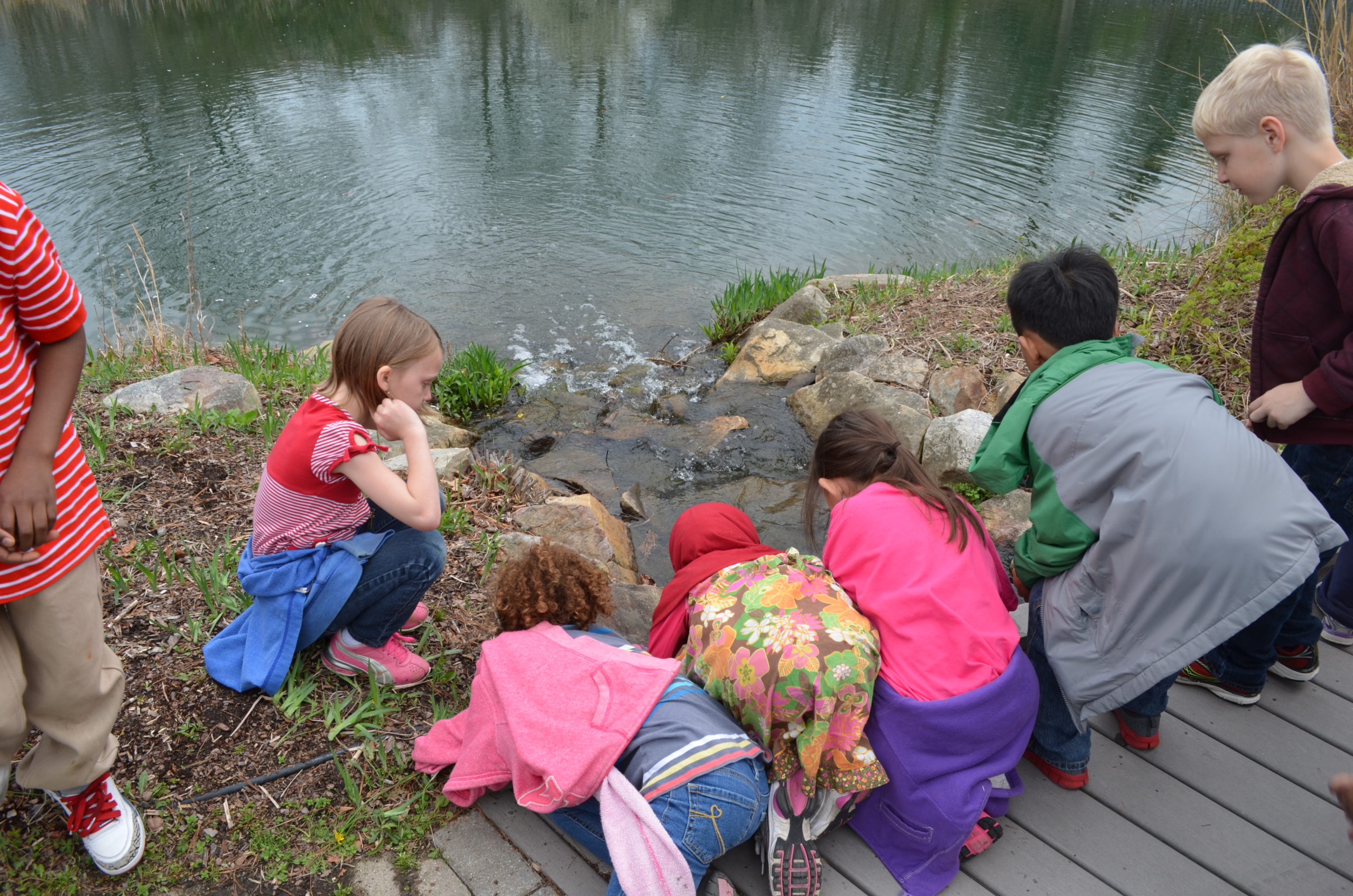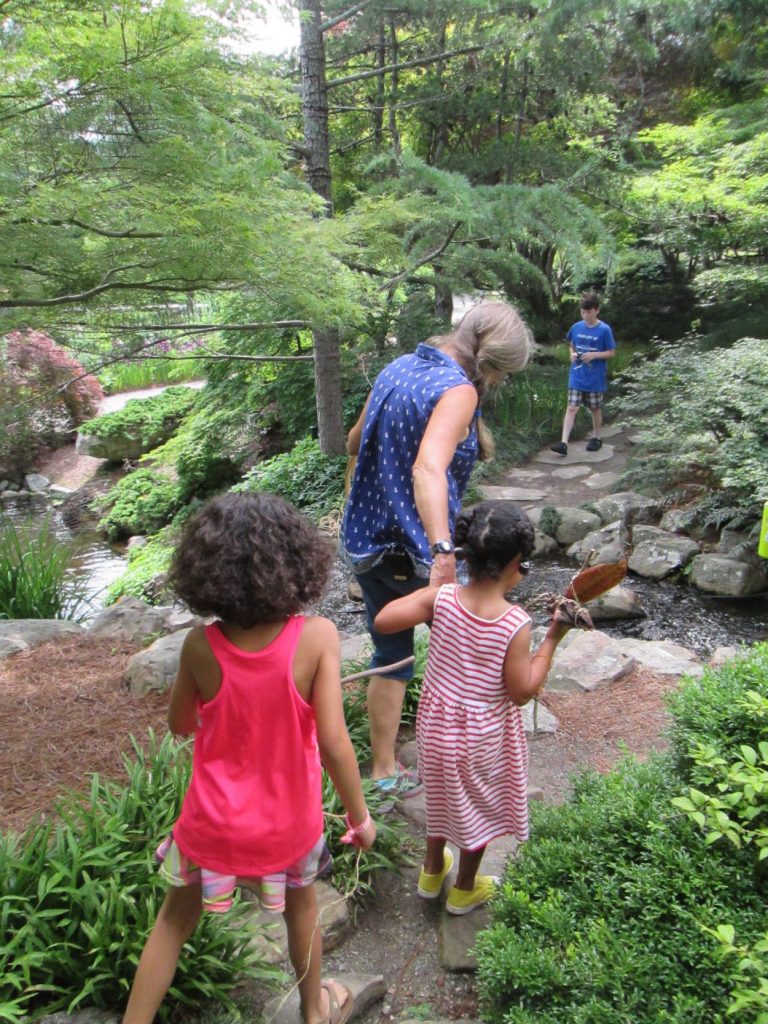Watershed Wonders
Seeing big, yellow school busses, full of excited students and teachers, roll into the Garden is a sight that we have missed. Typically, hundreds of classes a year visit us for field trips. Students learn about the wonders of how plants grow, the many benefits of trees, and the importance of keeping our waterways healthy.

These students are getting a close-up view of how water flows from the stream in the Asian Valley to the West Island wetland.
Like everyone, we did not expect our field trips to come to an abrupt halt this past spring. This situation made us think a lot about how to prepare for times that we cannot meet with students and teachers in person.
We were led to create our first virtual field trip package. This package contains a recorded video, suggested activities and additional resources. We hope to inspire experiential learning in new ways with these educational tools.
Watershed Wonders: A Virtual Field Trip
Our initial attempt to create a virtual field trip package is called Watershed Wonders. It provides an overview of the water cycle, explains the role plants play in healthy watershed systems and discusses human impact on these systems. It is designed to touch on Virginia Standards of Learning Science objectives for third-seventh grades.
We hope to learn from this initial pilot and would love your feedback. Please watch the video and take a peek at the supplemental materials. Let us know what you think by filling out this survey. While you are reviewing the materials, here are a few questions to think about.
- Which components of the virtual field trip package are most effective?
- Could this virtual field trip package be incorporated into the existing curriculum?
- What sort of activities and resources could be added to improve the field trip package?
With no further adieu, here is the video.
Please also download out the Watershed Wonders Activities (PDF) and Watershed Wonders Resources (PDF) that accompany the video.
Test What You Learned about Watersheds
Here’s a super quick quiz to see what you learned. We’d love to know what you think of this field trip. You can let us know what you think by filling out this survey.
Moving Forward With Virtual Field Trips
Stay tuned for the second part of our Watershed Wonders pilot, which will be released in a couple of weeks. It will focus on the functions of a wetland ecosystem and indicators of a healthy waterway and explore plant and animal adaptations.
Stay tuned! This fall, we hope to have virtual field trip packages available for preschool through middle school classes. Teachers will be asked to register for these free programs. Upon completing the registration process, we will provide the virtual field trip package that is requested.
By the way, if you would like to make a watershed model like the one in this video, PBS Kids and The Virginia Department of Environmental Quality, offer some great ideas for getting started.
The Alliance for the Chesapeake Bay, the Chesapeake Bay Foundation, RVAH2O, and the James River Association offer additional information about ways we can keep our local watersheds healthy.
Watershed Wonders aims to meet the following Virginia Public Schools Standard of Learning 2018 Science Objectives:
3.7 The student will investigate and understand that there is a water cycle and water is important to life on Earth. Key ideas include
a) there are many reservoirs of water on Earth;
b) the energy from the sun drives the water cycle; and
c) the water cycle involves specific processes.
3.8 The student will investigate and understand that natural events and humans influence ecosystems. Key ideas include:
a) human activity affects the quality of air, water and habitats;
b) water is limited and needs to be conserved;
c) fire, flood, disease, and erosion affect ecosystems; and
d) soil is a natural resource and should be conserved
4.8 The student will investigate and understand that Virginia has important natural resources. Key components include:
a) watersheds and water;
b) plants and animals;
c) minerals, rocks and ores;
d) forests, soil, and land.
6.8 The student will investigate and understand that land and water have roles in watershed systems. Key ideas include
a) a watershed is composed of the land that drains into a body of water;
b) Virginia is composed of multiple watershed systems which have specific features;
c) the Chesapeake Bay is an estuary that has many important functions; and
d) natural processes, human activities, and biotic and abiotic factors influence the health of a watershed system.
6.9 The student will investigate and understand that humans impact the environment and individuals can influence public policy decisions related to energy and the environment. Key ideas include
a) natural resources are important to protect and maintain;
b) renewable and nonrenewable resources can be managed;
c) major health and safety issues are associated with air and water quality;
d) major health and safety issues are related to different forms of energy;
e) preventative measures can protect land-use and reduce environmental hazards; and
f) there are cost/benefit tradeoffs in conservation policies.
LS.5 The student will investigate and understand that biotic and abiotic factors affect an ecosystem. Key ideas include
a) matter moves through ecosystems via the carbon, water and nitrogen cycles;
b) energy flow is represented by food webs and energy pyramids; and
c) relationships exist among producers, consumers, and decomposers.
LS.9 The student will investigate and understand that relationships exist between ecosystem dynamics and human activity. Key ideas include
a) changes in habitat can disturb populations;
b) disruptions in ecosystems can change species competition; and
c) variations in biotic and abiotic factors can change ecosystems.
